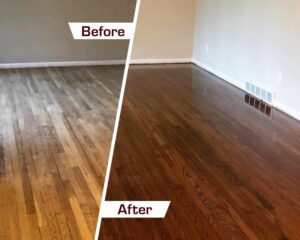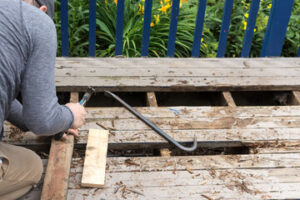If your hardwood floors are looking dull, scuffed, or scratched, you may want to consider refinishing them. Hardwood Floor Refinishing Bergen County NJ is a much cheaper option than replacing your flooring.
Refinishing entails sanding the existing wood and staining it a new color. We offer both oil-based and water-based polyurethanes.
All furniture will need to be removed from the room prior to applying the finish. We will schedule a time to apply the final coat of finish with you.
Hardwood floor refinishing is a process that involves sanding, cleaning, staining, and sealing the wood floors. If your hardwood floors are starting to show signs of wear and tear, it’s a good idea to call in a professional flooring contractor to come and refinish them. This process will take a few days, so it’s best to choose a time that works well for your schedule.
Before refinishing your hardwood floors, you’ll want to clear the area and remove any furniture from the room that will be sanded. You should also apply plastic sheeting to the doors of your home to keep dust from migrating into other areas of the house. The sanding process can create a lot of dust, so it’s important to close windows and shut off vents in the room where you’re working.
Once the sanding is done, you’ll need to clean your floor thoroughly to remove any dust and debris that may have settled on the surfaces. You should then wipe the floor down with a cloth or mop that’s dampened with water or a mild solvent like mineral spirits. This step is especially important if your floors are darker, as dirt and dust can mar the finish.
The next step in the refinishing process is to screen the floor, which is a light sanding of the surface that’s done with an electric sander. This step isn’t always necessary, but it’s a great way to restore the beauty of your hardwood floors. It’s important to sand with the grain of the wood and use light pressure when screening the floors.
After the floor has been screened and cleaned, you can begin staining the hardwood floors. This is the final step before you can move your furniture back into the rooms. It’s important to follow the stain manufacturer’s directions when staining your floors. If you are using a water-based stain, it can take up to 24 hours for the stain to dry completely.
Refinishing your hardwood floors will help preserve them for years to come, and it can improve the overall look of your home. It’s also a great way to get rid of the craters and crevices that can attract unwanted pests.
Sanding
Getting a professional to do the job is usually more cost-effective than doing it yourself, although you will need to buy sanding disks and stain or polyurethane. This can add up, especially if you want to experiment with different stains. Plus, a pro will have the proper tools and experience to make sure the job is done properly.
Before starting sanding, the floor should be completely clear of furniture, wall hangings, window treatments, and anything else that might get in the way or be damaged during the process. This also means pulling up any heating grates and carpet tacks that may be embedded in the wood flooring. Then, sweep the floor and vacuum it thoroughly to remove dust and dirt. Next, if there are any gouges or chips in the wood flooring that need to be repaired, this should be done with wood putty and left to dry.
When refinishing hardwood floors, it’s best to use a vacuum-equipped “dustless” sanding machine, as this will reduce the amount of dust that is kicked up during the sanding process. However, if you don’t have this equipment, then you will need to sweep and vacuum the floor frequently to rid it of the excess dust. Regardless of what type of sanding machine is used, it’s important to sand in the direction of the grain. This will help create a smooth surface and prevent the wood from becoming warped over time.
It’s also important to note that sanding will not completely remove deep scratches, gouges, or stains. This is because it only takes off about 1/16 inch of the existing surface, so damage that is deeper will still be apparent once the new finish is applied.
If your floors are in good condition and just need a refresh, it may be possible to skip the sanding process altogether and just buff the floors and apply a new coat of polyurethane. This is called screening and recoating, and it’s a great option for people who have appropriated floors that aren’t quite ready for a full refinish.
Staining
While wood floors are a beautiful addition to any home, they can become damaged and dull over time. Whether from normal wear and tear or water damage, it’s important to understand that there are options to restore them. One option is resurfacing, but another is refinishing. Refinishing is more extensive, but it can help improve the overall appearance of your floor and increase its lifespan.
Staining is an important process that should be done with care. It can be difficult to get the color right, and even the slightest misstep can result in a completely different color or shade than you originally intended.
This step can be messy, so it’s essential to protect your skin and clothing by wearing rubber gloves and a mask. It’s also wise to have a few rags on hand to wipe off excess stains and help maintain a clean working surface. This is especially true if you’re using a water-based stain. This type of stain is more likely to smear than oil-based stains and can be difficult to remove once it’s dry.
It’s also important to thoroughly stir your stain before applying it. This will ensure that all of the liquid is well mixed and doesn’t contain any uneven pigments. It’s also a good idea to apply the stain in small sections to avoid overworking the wood, which can cause it to look blotchy.
Once the stain is applied, it’s important to let it soak in before wiping it down with a cloth or sponge. This will help to create a visually appealing base coat and reduce the likelihood of flaws or streaks.
Depending on the color you’re going for, it may be necessary to apply a second coat. If you’re unsure of how much stain to apply, consult a professional. They can provide you with samples of various shades and recommend how much to apply.
It’s also a good idea to use a t-bar or similar tool to pop the grain prior to staining. This will open up the pores of the wood and make it less likely to appear blotchy after your stain is applied. This is a vital step, particularly for dark stains or those that will be refinished with water-based polyurethane.
Finishing
A new coat of finish will give your floors the last touchups they need as well as provide a fresh and appealing color. A lambswool applicator is the best tool to use for this part of the process. It allows for a smooth and even application of wood stain and can be stored in a plastic bag overnight for use again.
When you’re ready to apply the final coat, it’s a good idea to keep all furniture out of the room. Also, close all windows and doors, and tack down any loose floorboards with finishing nails. Finally, cover any vents or doorways in the room with tarps to protect them from sawdust.
While this might seem like a lot of work, it’s worth it to have beautiful floors. It’s best to do this refinishing project in stages rather than all at once and take your time as you go. This will allow you to better focus on the process and get your work done correctly.
Once your floors have been sanded, they will need to be vacuumed and mopped to remove any dust or debris left behind. Then they can be sprayed with a hardwood flooring cleaner or your own mix of 10 parts water to 1 part white vinegar. Next, hand-sand the perimeter of your hardwood areas using 180-grit sandpaper. This will get into any nooks and crannies that the floor buffer missed, as well as any edges around the baseboards.
After sanding, the floor will need to dry completely before you can recoat it. This is a good opportunity to clean the hardwood and to wipe down cabinets or other surfaces in the room as needed. Once the floor is dried, you can choose between a water-based polyurethane, a water-resistant polyurethane, or an oil-based stain. Oil-based finishes are slower to dry and smell worse, but they offer a superior sheen.
It’s important to determine whether your hardwood floor needs a full refinish or simply a recoat. If the floors are still in good shape and don’t have deep scratches or gouges, a screen and recoat may be all that is needed.



 Whether you’re looking for a plumber to fix your plumbing problems or hiring one for your business, there are several qualifications you should be aware of. Plumbers need to be licensed and have years of experience working in the field. These requirements can vary from state to state.
Whether you’re looking for a plumber to fix your plumbing problems or hiring one for your business, there are several qualifications you should be aware of. Plumbers need to be licensed and have years of experience working in the field. These requirements can vary from state to state.